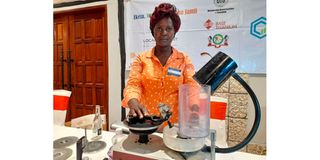How I switched from gemstone mining to a jewellery dealer

Holiness Mwadime , a jewellery entrepreneur. She makes and sells earrings, rings and necklaces made of gemstones.
What you need to know:
- Holiness Mwadime is among the few female artisanal miners in Taita Taveta County.
- She started off as a gemstone miner.
- She buys the stones from miners, cuts and polishes them before using them to make jewellery.
Kenya’s artisanal mining sector has predominantly been a man’s field. Stereotypes abound on women’s ability to flourish in this lucrative sector.
It is the desire to break such socio-cultural stereotypes and other challenges that forced 42-year-old Holiness Mwadime, to find her niche in the artisanal mining value chain.
She is among the few female artisanal miners in Taita Taveta County. She tells nation.africa that she previously worked in the mines where she faced numerous challenges, which forced her to seek an alternative means of livelihood.
Ms Mwadime and other women had registered for a mining licence, hoping they would explore and get gemstones from the Mkuki area, in Taita Taveta County.
A gemstone is a piece of mineral used to make jewellery and ornaments. Among the gemstones found in Taita Taveta County include Tsavorite, ruby, tourmaline, red garnets, green garnet, Tanzanite and iron ore.
“At the time, we were being trained by the Association of Women in Mining (Awim) an NGO, and I thought that instead of going to the mines, I could buy the gemstones from other miners and do some value addition before selling them,” she says.
She started mining in 2016 after, together with other women from Taita Taveta County, they formed a community-based organization (CBO) and got a mining licence.
Specialised equipment
She, however, stayed for three years prospecting and did not get anything. This is because they lacked the technology that would assist in finding exactly where the gemstones are.
“We had no specialised equipment, we would just prospect that the stones are at a certain place then start digging tunnels, more than 10 meters deep,” she says.
She also had to stay away from her family for long periods. The mother of four would go deep into the mines for more than a week, but still come out without any gemstones, finding it difficult to feed her children.
Other than that, she had no protective gear and risked being buried in the sand because they only used hoes and spades to dig out the sand.
She and other miners also risked being attacked by wild animals because the mines are located near Tsavo National Park.
The group needed at least Sh10,000 a day to hire a machine that would help dig up the minerals, an amount that was difficult to raise.
Mining site
As a result of the numerous challenges, she sought an alternative venture within the same line - value addition for the gemstones.
She registered Hols Gems Enterprises as a business in 2019, after operating at the mining site for one year. It cost her about Sh2,500 to register her business online.
“I thought of getting stones from fellow miners, some of which they had not sold to make pendants, earrings and necklaces,” she says.
She buys the stones from miners who sell to her at varying prices, depending on the stone size, and the amount she orders. She then goes to a gemstone centre where she cuts and polishes them.
Ms Mwadime buys the stones and makes rings, necklaces, earrings and bracelets out of them.
She uses a hired machine to cut them into the desired shape.
This is unlike before when she and other miners would give the gemstones to brokers who go to the gem centres themselves and sell the minerals at a higher cost.
On a recent visit to Diani, she displayed a ring at the Madini Mazingira na Ustawi wa Jamii Annual Conference and Exhibitions expo that was sold at Sh10,000. It was made with silver and ruby as the gemstone.
“I do not have a permanent shop, but I advertise my business through social media like my Whatsapp status and get buyers,” she explains.
She also attends mining exhibitions where she displays her work. Here, she meets interested clients who either make orders, or buy the jewellery on display.
Exhibitions
“Kenyans are currently more interested in basic needs and cannot afford the luxury of buying rings or necklaces due to the economy," she says.
This has also affected her profits. She says it has become difficult to get buyers during exhibitions.
For instance, a ring that cost her Sh3,000 to make would be sold at Sh5,000 or Sh6,000, but this depends on the market because she can also fetch Sh10,000 from it.
Her earrings go for between Sh500 and Sh1,000. Their prices are also determined by the quality of stone, and the number and sizes of stones used.
Ms Mwadime hopes to expand her business locally, and eventually global, in the coming years. She intends to list it online on various business sites, to attract clients from across the world.
She also intends to help other women artisanal miners to set up their businesses and become fully independent.





